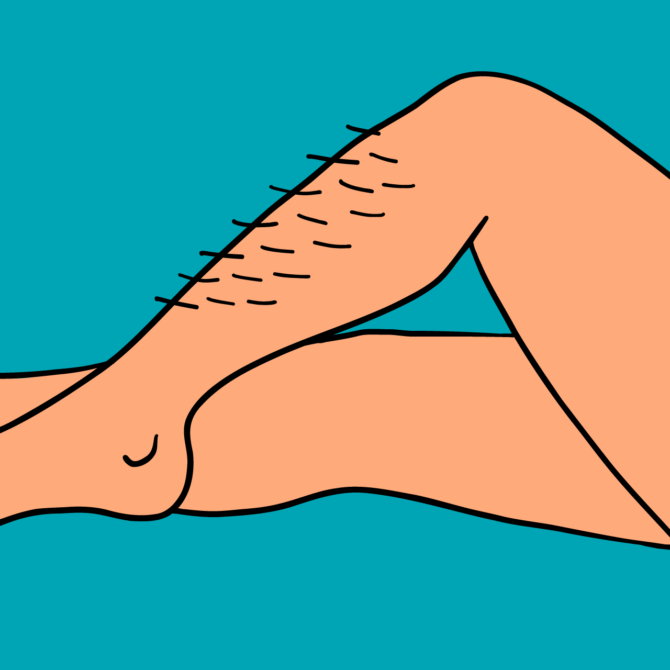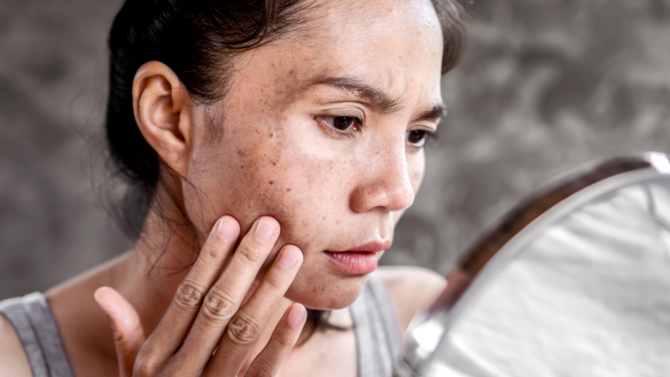Does laser hair removal hurt?
The sensation of laser hair removal is often likened to the snapping of a rubber band on your skin, so it’s certainly not pain-free. It is relatively quick though, and how uncomfortable the experience is really depends on your individual pain threshold, as well as the type of laser being used (as some have pain-relieving cooling mechanisms), and the area being treated. For example, the bikini area is known to be more sensitive than the lower legs.
As for other methods of hair removal, the level of discomfort can vary from person-to-person too. Shaving and depilatory creams are generally painless, as they only remove hair from the skin’s surface. Waxing and epilation may cause some discomfort, especially during the removal of hair from the root, however as with all things pain tolerance varies among individuals.
Who can benefit from hair removal?
Hair removal is suitable for many individuals, however, factors like skin colour and hair type may affect the efficiency of certain methods. Black skin in particular needs to be treated with care when it comes to light-based therapies, as inappropriate or incorrect treatment could not only be ineffective, but could even cause burns or pigmentation disorders.
Below is a list of each hair removal method’s suitability for certain individuals:
Laser Hair Removal and Intense Pulsed Light (IPL): Best for individuals with fair skin and dark hair as the technology requires a clear colour distinction to target the hair follicle and work effectively. This means it can be ineffective on light-coloured or grey hair, as well as for Black skin. That said, advancements in the sector are allowing more skin and hair types to be treated, both in clinic and via at-home devices.
Shaving and Electrolysis: Suitable for all skin types and hair colours.
Depilatory Creams: Suitable for most skin types and hair colours, although those with sensitive skin should be careful to patch test before use.
Waxing: As waxing can cause temporary redness or irritation, anyone with an active skin condition or sensitive skin may wish to use another method.
Epilation: Suitable for most skin types and hair colours, but may not be suitable if you have a low pain threshold.
I have Black skin. Can I have laser hair removal?
As referenced above, nowadays, the good news is yes. Darker skin tones have always been much trickier to treat safely with lasers because old technologies were unable to distinguish between melanin in the hair and that in the skin. Thankfully, the newest types of lasers can help. Just make sure the clinic you choose uses one of these more modern lasers and has experience treating Black skin.
I have very light or red hair. Can I have laser hair removal?
Unfortunately, laser hair removal is usually unsuitable for those with blonde, grey, white or red hair. This is because there simply isn’t enough pigment for the laser to detect. If you are unsure if your hair type is suitable, you should book a consultation to find out your best options.
How much is laser hair removal?
The cost of hair removal varies considerably depending on the method chosen, the area or areas you want to treat, and where you decide to have it. For example, in a clinic, laser hair removal can range from a few hundred pounds to several thousand, and that is influenced by the specific device used and the number of sessions you may require. At-home options, such as IPL devices, tend to cost a few hundred or so when purchased, but can be a cost-effective option if you are willing to commit to results that take a little longer to appear. Shaving is widely considered the most affordable option.
Is laser hair removal permanent?
Laser hair removal offers long-term hair reduction, but it is probably most accurately described as semi-permanent, because maintenance sessions may be needed over time to address any regrowth. In fact, the goal is to achieve around an 80 per cent reduction in hair after the recommended course of treatments, with the hair then starting to grow back thinner, lighter and sparser.
You can see how that compares to other methods of hair removal below:
Temporary Hair Removal: Shaving, depilatory creams, sugaring and waxing all offer temporary hair removal because they target hair at the skin’s surface level – not at the deeper follicle. This means that your hair typically grows back fairly quickly, within a few days for shaving and a few weeks post-waxing.
Semi-Permanent Hair Removal: As mentioned, laser hair removal is a semi-permanent method of hair removal, as is IPL. Both use light energy to target and damage the hair follicle, inhibiting (but not totally stopping) future growth.
Another semi-permanent option is epilation, as epilators mechanically pull hair from the root. This offers longer-lasting results than the listed temporary methods, but is still not a permanent solution.
Permanent Hair Removal: Methods of totally permanent hair removal are limited, but electrolysis – which uses an electric current to destroy the hair follicle – can provide permanent results for small areas, especially on the face.
How many sessions are needed for laser hair removal?
While there are some methods of hair removal, such as waxing and sugaring, which offer immediate results, the hair will grow back overtime so you will need repeat sessions to maintain a hair-free appearance. The time between treatments can vary but is possible once visible regrowth appears.
Other methods such as laser hair removal require multiple sessions before you see an effect, although the results can be much more long-lasting. This is because laser hair removal is most effective during the anagen phase of the hair growth cycle, when the hair follicle is actively producing hair. Since not all hair is in the anagen phase simultaneously, multiple sessions are necessary to target the hair in different growth stages. Each laser hair removal session also needs to be spaced several weeks apart to effectively target the hair in its various stages.
The exact number of sessions you may need depends on your individual hair growth patterns, your skin and hair colour, the area being treated, and the exact device and mode that is used by your practitioner. That’s why a good consultation for in-clinic appointments, and reading the instructions of any at-home tools carefully, is always important to manage expectations. Typically, a full series of laser hair removal sessions ranges from six to eight treatments, spaced around four to six weeks apart.
Is laser hair removal safe?
When performed by a trained practitioner, laser hair removal is considered safe, as long as the safety guidelines and proper skin type assessment are adhered to. In particular, it is important that the most suitable laser and the right settings are used for your skin tone and type. The main risks of laser hair removal, including skin irritation, blistering or scarring from using too high a setting, or changes in pigmentation especially for darker skin tones, are minimised when procedures are carried out appropriately. Wearing eye protection during the treatment to avoid eye injury is also essential, while proper aftercare, including sun protection, should also be used to minimise potential side effects.
As for other hair removal methods, common solutions like shaving, depilatory creams, epilation, and waxing are considered safe when done correctly too. The main side effects are temporary redness or irritation, alongside some brief pain or discomfort.







 The Tweakments Chatbot
The Tweakments Chatbot